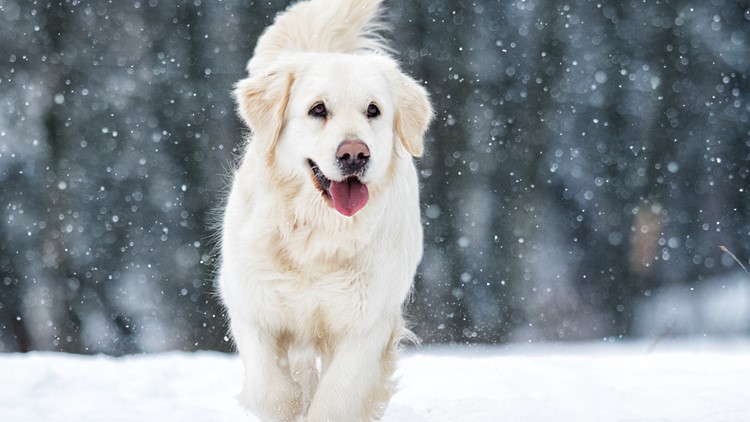In many states across the country, temperatures have been extremely low, bringing snowy or icy weather along with them. This has led to many dog owners wondering how they can best protect their pets as they take them on walks, and an increase of online claims on how cold weather can affect dogs.
VERIFY readers, including Susan, reach out to ask about dog safety in the cold. We VERIFY answers to five top questions about how to protect your dog in winter weather.
THE SOURCES
- American Kennel Club
- American Veterinary Medical Association
- Cornell University’s Canine Health Center
- The Humane Society
- Southern Cross Pet Insurance
- Lucky Puppy Grooming
- Close Veterinary Clinic
- Pride Veterinary Referrals
- Medivet
- A VCA Animal Hospitals article
- Kansas State University Agricultural Research and Extension
- American Society for the Prevention of Cruelty to Animals
- Small Door Veterinary
- A Pet Poison Helpline article
- Commonwealth Veterinary Hospital
WHAT WE FOUND
1. Is it safe for dogs to eat snow?
THE ANSWER
No, it is generally not safe for dogs to eat snow. Underneath the snow, there could be objects or toxins that make dogs sick.
There’s not much that can be done to prevent your dog from eating snow while outside, but it's important to keep in mind the potential health problems that can arise with dogs eating large amounts of contaminated snow.
“A little bit of snow is generally safe for dogs to eat and snapping at snowflakes is good fun,” but “grit, stones or small objects can be concealed by the snow and these can be bad for your dog’s health,” Southern Cross Pet Insurance says.
Harmful substances, like antifreeze or other snow and ice-clearing chemicals, may be mixed in with the snow and can make dogs sick, Close Veterinary Clinic explains.
Ethanol glycol is the active ingredient in antifreeze. If you suspect that your dog ingested antifreeze, Cornell’s Canine Health Center says to “seek veterinary care immediately” as ethanol glycol can be fatal if ingested.
The American Society for the Prevention of Cruelty to Animals says dogs that consume ice melts could experience symptoms such as an upset stomach, diarrhea, or in more serious incidents, tremors and seizures.
A Pet Poison Helpline article explains that sodium chloride, a common ingredient in many ice melts, is toxic to dogs. Depending on the amount of sodium chloride in the ice melt and the weight of the pet, consuming it can be lethal, Small Door Veterinary says.
2. Is "pet safe" ice melt really safer for pets?
THE ANSWER
Yes, “pet safe” ice melt is safer for pets than other forms of ice melt.
Normal ice melts commonly contain sodium chloride, potassium chloride, calcium chloride and magnesium chloride, the ASPCA says. ‘Pet safe’ ice melt does not contain sodium chloride, as “large ingestions of sodium chloride can lead to sodium toxicosis and a dose of 4g/kg of sodium chloride can be lethal to dogs,” Pet Poison Helpline says.
No ice melt is completely safe, the Society for the Prevention of Cruelty to Animals International says. “Pet safe” ice melts can still cause irritation or gastrointestinal issues as they can contain potassium chloride, calcium chloride, urea and magnesium chloride.
Commonwealth Veterinary Hospital says “pet safe” ice melt products that contain calcium or magnesium chloride salts can cause electrolyte imbalances, vomiting, drooling or excessive thirst in dogs who ingest the product in large quantities.
Calcium chloride can also cause ulceration to the mouth, the ASPCA says. The ASPCA adds that while ‘pet friendly’ ice melts typically contain safer ingredients, it's still “best to be careful with them.”
Ice melts can also cause dogs’ paw pads to be irritated and crack, the ASPCA says. The organization recommends using boots or paw wax, and wiping paws with a damp cloth as soon as the dog comes inside.
“Pet safe” ice melts containing urea may be less rough on the paws as they are less corrosive than salt, Kansas State University Agricultural Research and Extension says.
3. Can dogs get frostbite?
THE ANSWER
Yes, dogs can get frostbite. The American Kennel Club says dogs are at risk of frostbite if the temperature is below 32 degrees Fahrenheit.
The AKC adds that a dog’s paws, ears and tail are most likely to get frostbite. While frostbite itself is not typically fatal, the AKC explains the drop in blood flow can cause tissue damage, and the condition can lead to life-threatening hypothermia.
If the frostbite is severe, there may even be permanent damage that could lead to amputation, VCA says.
“The clinical signs of frostbite may take several days to appear, especially if the affected area is small or on non-weight bearing areas, such as the tip of the tail or ears,” according to a VCA article.
Symptoms to look out for include pain or tenderness, swelling, skin discoloration and stiffness, the American Kennel Club says.
It’s important to monitor how your dog reacts in cold weather, as some dogs are more sensitive than others. Cornell University’s Canine Health Center notes that “a dog’s cold tolerance will vary depending on age, size, nutritional status, health and coat thickness.”
The Canine Health Center says that puppies and dogs that are small, short, have thin coats or are older may have more difficulty regulating their body temperatures.
The American Veterinary Medical Association adds pets with “diabetes, heart disease, kidney disease, or hormonal imbalances (such as Cushing's disease) may have a harder time regulating their body temperature, and may be more susceptible to problems from temperature extremes.” They recommend consulting with a veterinarian if there is any concern in determining the temperature limits for a specific dog.
4. Can boots help protect a dog’s paws in ice or snow?
THE ANSWER
Yes, veterinarians and other experts say that boots can help protect a dog’s paws in ice or snow. Wearing boots can also protect dogs from ice melts and ice collection in their paws.
The salt used on many icy roads and sidewalks can be sharp and damage paw pads. “Prolonged contact can lead to chemical burns, dryness, and painful cracking,” Medivet says. Wearing boots can “provide protection against the elements, as well as extra grip on slippery surfaces,” the veterinary group adds.
The American Veterinary Medical Association says “arthritic and elderly pets may have more difficulty walking on snow and ice and may be more prone to slipping and falling,” so in these cases, wearing boots can also provide traction.
Because ice melt can be toxic to dogs, wearing boots can prevent dogs from getting sick, as they often lick their paws. Small Door Veterinary says the boots can provide a “safe layer between their paws and the toxic anti-icing agents.”
Wearing boots can also help dogs feel more comfortable in the cold and protect from frostbite. “The cold surface can dry out paw pads, causing them to flake and crack,” the American Kennel Club says.
Some dogs may be sensitive to wearing boots, and if that’s the case, there are other recommendations to keep them safe without them.
The Humane Society says it's important to “wipe all paws with a damp towel before your pet licks them and irritates their mouth.” Small Door Vet says to soak the dog’s paws in warm water and dry thoroughly after a walk. Cornell University’s Canine Health Center adds that “applying certain balms or petroleum jelly to paw pads may help prevent and alleviate cracking paw pads.”
5. Is it okay to groom long-haired dogs in the winter?
THE ANSWER
Yes, it is okay to groom long-haired dogs in the winter. Although longer coats can keep a pet warmer, grooming dogs can keep them from becoming matted.
“The combination of less outdoor activity, colder temperatures, and moisture from snow or ice can all mean that hair becomes more matted or tangled than ever,” which Lucky Puppy Grooming says can “ultimately lead to skin irritation or other skin conditions.”
Matted fur can create irritation and discomfort for dogs, and Pride Veterinary Referrals says that it can even lead to infections below the skin.
When grooming long-haired dogs in the winter, it's recommended to still keep in mind the weather and not to shave too short.
The ASPCA says to “never shave your dog down to the skin in winter.” You should instead “simply trim him to minimize the clinging ice balls, salt crystals and de-icing chemicals that can dry his skin.”
Cornell University’s Canine Health Center also says “a little strategic clipping, such as around their hind end, may help prevent snowball accumulation.”
Small Door Veterinary adds that it's important to “trim between-the-toes fur, so that it doesn’t accumulate ice and snow.”
The ASPCA recommends getting short-haired dogs “a coat or sweater with a high collar or turtleneck with coverage from the base of the tail to the belly.”
This story is also available in Spanish / Lee este artículo también en español: El cuidado de los perros en el invierno: Hoja de Datos VERIFY













